Introduction to how to grow Nasturtiums: Nasturtium plants are loved for their dazzling colors. They are fast and easy to grow when planted after the threat of frost has passed. However, they require neglect to thrive. Nasturtiums are available in almost every variety for every kind of gardening project:
- Bushy plants for borders and edges
- Trailing plants for walls and containers
- Climbers for added height
Moreover, the leaves and flowers are edible with a peppery tang, and even the seeds can be used in place of capers. Many vibrantly colored blossoms poked out of the masses of leaves on the Nasturtium plants. They have rounded leaves, similar to water lilies, and funnel-shaped flowers with a claw-like spur on the underside. The most popular shades of these flowers are yellow, orange, pink, red, or mahogany. Also available are subdued shades of yellow, cream, butter, and variegated varieties are also available.
Guide on how to grow Nasturtiums, essentials, best way to grow Nasturtiums, ideas, tips and techniques
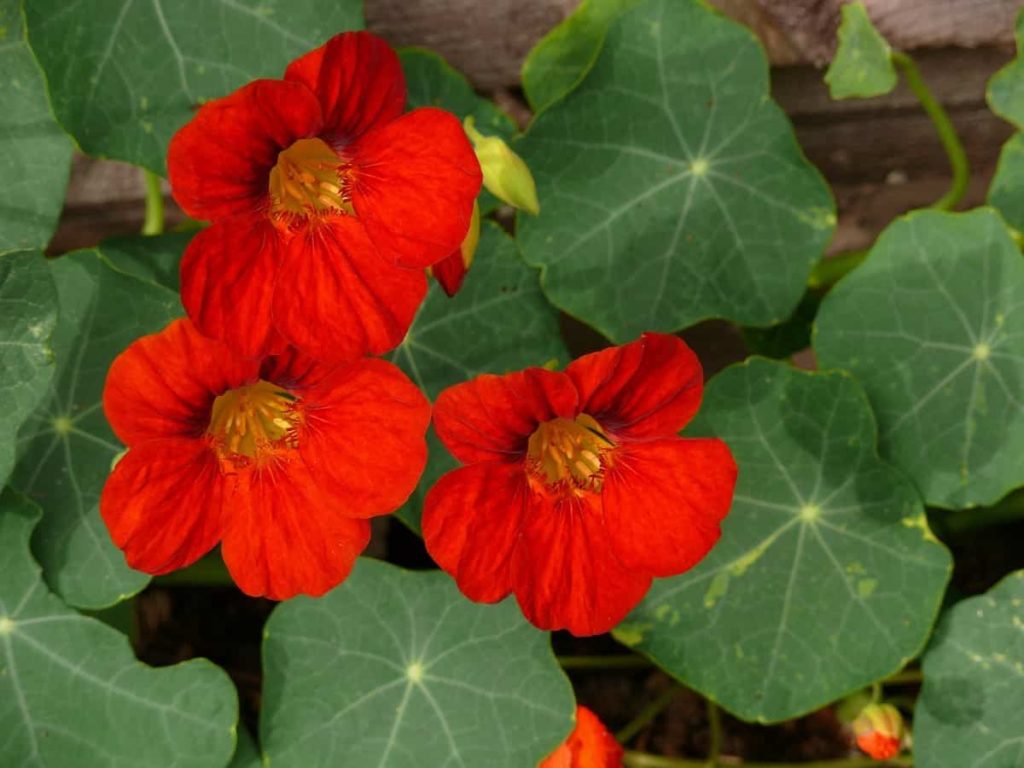
Essentials to grow Nasturtiums
Light
Full sun is best for growing and blooming Nasturtiums. However, they can tolerate a little shade, and in warmer climates, they may prefer it over the hot afternoon sun.
Soil
Good drainage is necessary for these flowers. Despite their drought tolerance, they appreciate a moderate amount of moisture.
Water
Nasturtiums generally require weekly watering. As a result, while they will survive some drought conditions, their flowering may diminish, and their foliage may become scrawny.
Humidity and temperature
Nasturtiums grow perennially in USDA zones 9 through 11. Most annuals, however, complete their life cycle within one growing season. Therefore, plant them after the last frost in the spring so that you can enjoy them until the fall frost. Furthermore, these plants are not overly particular about humidity levels, though they prefer average levels. However, extreme humidity and drying conditions may cause them difficulty.
Fertilizers
Nasturtiums won’t need to be fed during the growing season unless the soil is poor. Fertilizers can make them produce more foliage and fewer flowers. They grow best in lean-to-average soil.
Feeding
Plants should be fertilized with a balanced organic fertilizer before planting.
The best way to grow Nasturtiums
Since Nasturtium flowers do not transplant well, it is best to sow the seeds directly into the permanent location of the plant. Use peat pots if you must start nasturtium seeds and then transplant them without destroying the roots of the growing plants. Nasturtium seeds can be nicked or soaked overnight in warm water to improve their germination rate.
In case if you miss this: 23 Vegetables to Plant in the Rainy Season in India

Plant immediately in a container or in a part of the garden that allows for growth. Plant climbing nasturtium varieties near a trellis and train the colorful vines to climb well. You can add several to your spring and summer landscapes since you now understand how easy it is to grow Nasturtiums. These plants require no special care. You can plant them and forget about them, except to enjoy their vibrant colors.
Tips for growing Nasturtiums
- They will grow large, round, lotus-like leaves of medium green or green flecked with white in average soil. Then, a profusion of five centimeter-wide (two-inch-wide) trumpet-shaped, spurred flowers in orange, yellow, salmon, maroon, scarlet, or creamy white cover leaves, often with streaks and blotches of contrasting colors.
- Nasturtiums’ stems and leaves hold water well, making them an excellent choice for containers or gardens in low-rainfall areas. However, full-sun conditions are best for their growth and blooming.
- You can encourage some varieties to climb as soon as they sprout by coaxing the young stems. Plant your plants within five centimeters (two inches) of a wire fence or slender trellis to encourage them to grow.
- They look great hanging from a box, spilling over the edge of a container, or spreading around the garden in clumps. In addition to forming a thick carpet of flowers and leaves, they look great at the front of a border.
- The bright yellow blossoms of the variety ‘Moonlight’ brighten up an evening garden. In shades of cream, yellow, peach, and red, ‘Jewel of Africa’ flower and leaves are dotted with cream.
- Nasturtiums are only bothered by a few pests. First, a strong stream of water is used for rinsing off small, pear-shaped insect aphids that gather on buds and stem tips. The plants only need water during severe droughts and flower best without fertilizer.
In case if you miss this: Top 18 Flowers to Grow on the Terrace
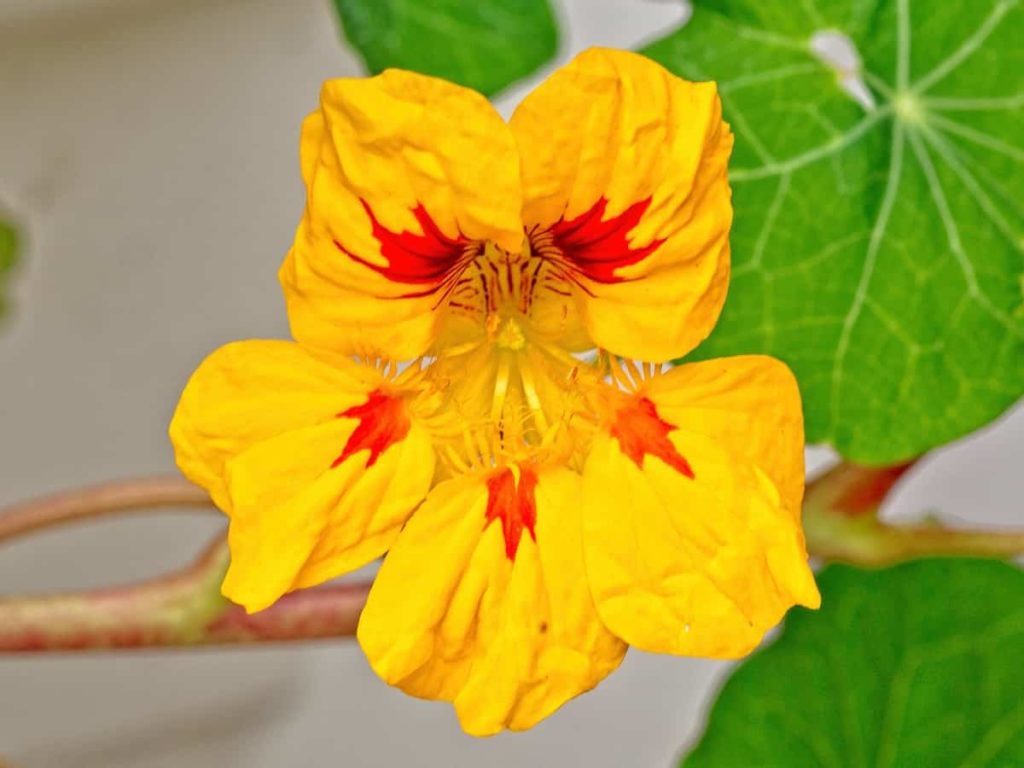
- It is beneficial to remove brown leaves that cling to the stems. The plant will remain tidy and perform well if trimmed with spent flowers and leaves.
- If you are growing Nasturtiums in a hanging container or window box, rejuvenate your plants halfway through the summer by snipping off the dangling stems, leaving at least 15 cm (6 inches) of stem at the base of the plant.
- The plant will sprout new flowering shoots within a week, making it appear dense and lush like a new planting.
- Plants of this species are readily available at garden centers, but they are the easiest to grow from seed.
- It would help if you planted the seeds directly in the ground after the danger of frost has passed because they don’t transplant well. Also, seed coats should be nicked or scarified before planting to facilitate moisture absorption.
- Seeds should be spaced 23 to 30 centimeters (9 to 12 inches) apart, barely covered with soil, and pressed lightly with a hoe to firm the soil around the seeds.
- Ensure a sprinkler head is attached to the watering can when watering the seedbed. The seeds take approximately one to two weeks to germinate.
- The low-maintenance nature of this plant makes it perfect for any outdoor space. Before you plant, consider these tips for getting the most from your Nasturtiums.
- Nasturtium plants are edible in every part, including their flowers, leaves, and seeds. In addition to their peppery taste, Nasturtiums’ flowers and young leaves are great for salads. The seeds are called ‘poor man’s capers’ as a substitute for capers. The seeds should be picked while still green and pickled in vinegar.
- You can collect the seeds and save them for next year when the seeds are ripe. You may also get seedlings in the future if you live in a temperate area where Nasturtiums self-sow. You can pull them up if you don’t want them.
- Plant the nasturtium seeds directly in the ground at a depth of 12.5 inches and a distance of 12 inches apart. Nasturtiums can also be started indoors 4-6 weeks before the last frost and transplanted afterward. After hardening off and all danger of frost has passed, sow the seedlings directly into the ground. Planting seeds should result in seedlings emerging in 7 to 10 days.
- Nasturtium plants don’t care about the type of soil they grow. Nasturtium plants grow exceptionally well on average to poor soil that drains well. Their optimal pH is 6.5. Fertilized soil can cause Nasturtium plants to produce excessive leaves and have minimal blooms.
- The flowers, leaves, and stems of Nasturtiums are eaten. Nasturtiums taste peppery and have a spicy taste. To harvest blooms and leaves for eating, pick early in the day (but after the dew has dried).
- After picking flowers, immerse them in cold water for a few minutes to keep them fresh longer. Flowers and leaves can be used right away or stored in a damp paper towel in the refrigerator. A tasty caper substitution is made by pickling the unripe seed pods.
- Planting trailing varieties is an excellent ground cover for shady areas and areas with poor soil. You can also train trails along a fence, cascade down from a container, or fill in a border. A dwarf variety grows low to the ground and is more mounded—plant in spaces with limited space.
In case if you miss this: DIY Balcony Garden Ideas, Tips, and Techniques
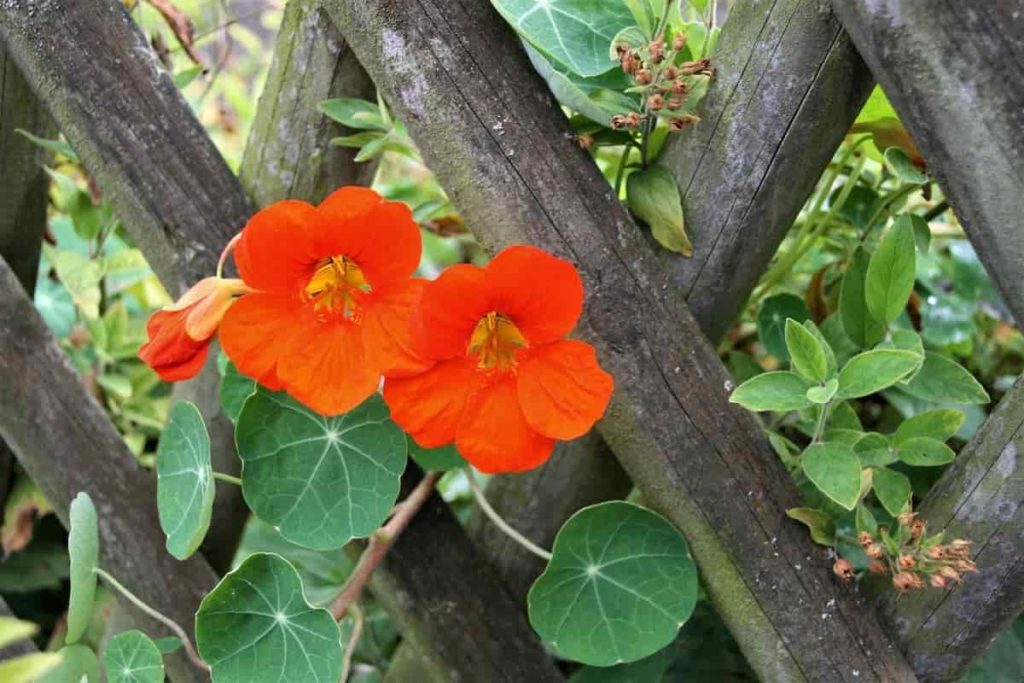
Ideas for growing Nasturtiums
Grow from seed
Grow from seed while seedlings are readily available in the spring. It is easy to grow Nasturtiums from seeds. Sow the seeds in the early spring by poking them about one centimeter deep into moist soil. Seedlings will be off and running soon after you thin them to 15 centimeters apart.
Configure pretty settings
Build a pretty pyramid. Drive a stake through the center of a wooden barrel. Fasten the string to the container’s edges with tacks after stretching it from the top of the stake to the edges. Plant climbing Nasturtiums around the barrel perimeter, train the vines up the strings, then use the barrel as a centerpiece in an herb garden or on a patio. Train the vines up a short trellis to create a low screen from trailing Nasturtiums. Beautiful flowers look even better with these forms.
The two go well together
Potted citrus and Nasturtiums go well together—plant bush-type Nasturtiums around the base of lemon, lime, or orange tree in a pot. The bright yellow, orange, and red blooms complement the citrus fruits’ colors. These plants and flowers look best together.
In case if you miss this: DIY Backyard Gardening Ideas, Plating Tips and Tricks
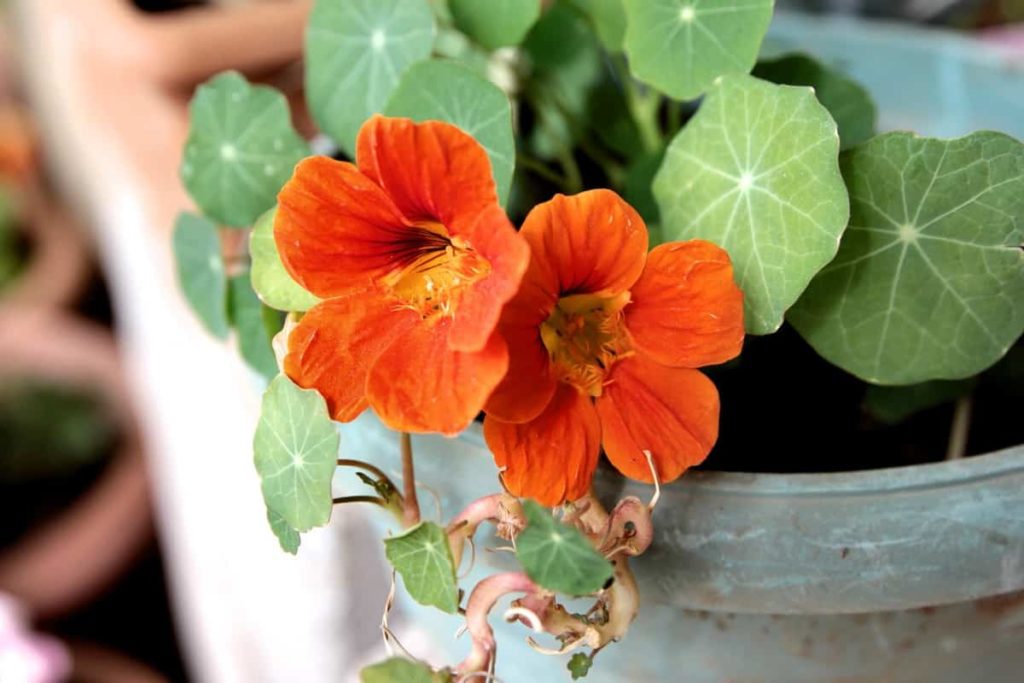
Put the plants in bundles
Add them to your vegetables—plant Nasturtiums between rows of vegetables, 30 to 45 cm apart. The blooms are edible, make a pretty ground cover, and repel insects. Add a few rights to a summer salad for visual appeal.
The right time to plant Nasturtiums
Nasturtium seeds should be started indoors at least four to six weeks before the last frost and planted outside only after all danger of frost has passed. Nasturtium seeds are easy to plant, and they can be direct sown in the garden. However, the seeds need to be sown two weeks before an expected frost. Overnight soaking of seeds will accelerate germination. Sow seeds 12 to 1 inch deep, five to six inches apart.
Plant Nasturtiums as companion plants
By growing Nasturtiums, you can keep pests away organically. Nasturtiums, for example, repel squash bugs, whiteflies, and borer flies. Nasturtiums planted near tomato plants, radishes, squash, and fruit trees are beneficial. However, Nasturtiums are a ‘trap crop’ (insects lay eggs in trap crops instead of other plants in gardens).
Encourage blooming
Nasturtiums do not need fertilizer to bloom. Growing green leaves is easy with nutrient-rich soil, but blooms are not expected. It is also beneficial to remove faded blooms to encourage more flowers. Finally, trim back container-grown plants to keep Nasturtiums looking tidy and producing flowers.
Techniques for growing Nasturtiums
- It is easy to grow Nasturtiums because of their quick germination and few requirements. Despite their basic needs of water and daylight, these flowers do not like a lot of fussing and do best when almost entirely left alone. Using too much fertilizer will give a gardener many green leaves but fewer bright-colored flowers. At the same time, to grow Nasturtiums successfully, you need to select a site that receives sufficient sunlight and drains well since the flowers do not do well in a constantly wet environment.
- It will be helpful to soak nasturtium seeds in warm water overnight before planting. Because the seeds will grow without soaking, it is not an absolute requirement, but it will help them sprout faster. It has large seeds that are easy to handle, but its coating is hard. Soak the seeds in water before planting to encourage easier germination and possibly better germination rates.
- The hard coating on the seed can sometimes be responsible for the failure of nasturtium seeds to sprout. The Nasturtium can be encouraged to sprout instead of pre-soaking by nicking the seed coat with a small blade. The seeds dislike handling once they start growing, so complex transplanting them. Plant them straight into the ground or in a container, or start them in peat pots.
- Nasturtiums require adequate space to grow, depending on the type of Nasturtium selected. Climbing Nasturtiums look great along fences and trails from hanging baskets, while dwarf varieties require less space and are ideal for smaller gardens. You can plant them in containers and window boxes, too. Nasturtiums are best planted in a container. Trailing Nasturtiums and larger varieties require more space depending on the container’s size. Nasturtiums will bloom bright and colorfully until frost if given enough sunlight and space.
- It is also essential to provide enough sunlight when growing Nasturtiums. If there is not enough sunshine, the plants will produce lots of healthy green growth but few flowers. The plants need water to grow. During the hottest part of the growing season, it is essential to water these flowers frequently. During other times, regular watering is adequate. Nasturtiums are popular among gardeners because the flowers are edible, so they are not sprayed with pesticides if they are to be used in recipes.
In case if you miss this: Top 10 Fruits To Grow In Hydroponics
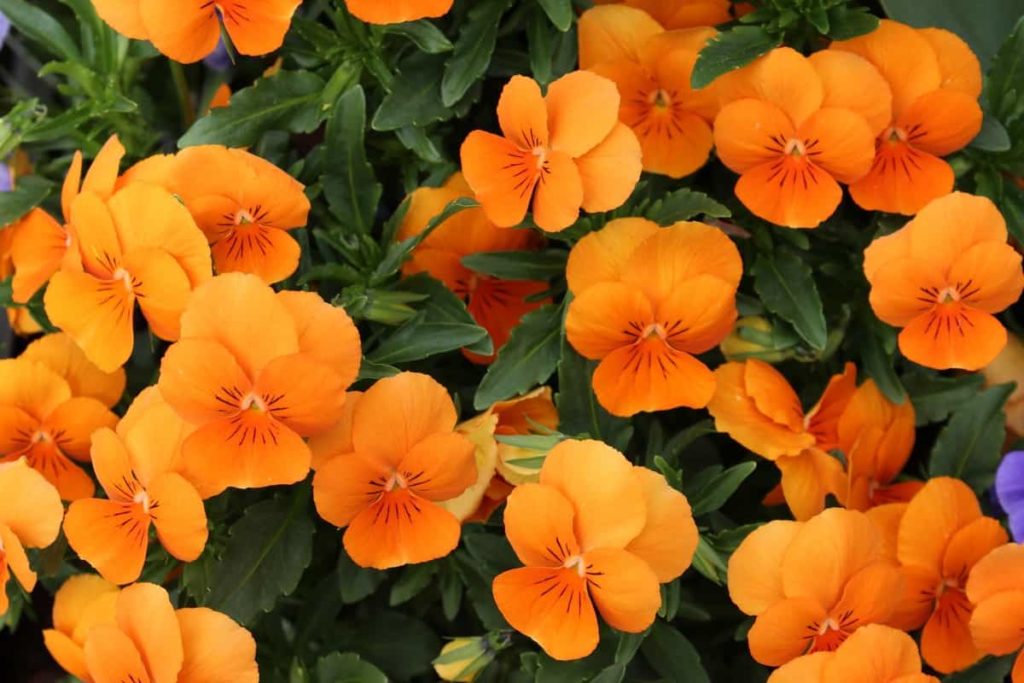
Commonly asked questions about growing Nasturtiums
1. Nasturtiums require full sun to grow?
It would help if you started growing Nasturtiums in an area with full sunlight that receives at least six to eight hours of sunlight a day. Nasturtiums won’t necessarily bloom to their full potential without adequate sunlight despite tolerating partial shade.
2. Is Nasturtium a perennial or an annual?
In planting zones 9, 10, or 11, many nasturtium varieties can be treated as perennials, returning every year with vibrant colors. However, Nasturtiums typically grow for one season and have some longevity. The plants can keep giving until the first winter frost if planted after the last frost and cared for properly.
3. Is it possible to eat Nasturtiums?
Nasturtium is a plant that is eaten. Vitamin C is abundant in this plant, and it is believed to have antibiotic and healing properties. All plant parts are edible, making it a cheerful addition to salads, soups, and desserts served during the summer. Authentic edible flowers with a distinctive color and a subtle peppery flavor will please any palate. You can even harvest and use the plant’s seeds much like you would a caper in cooking.
4. Is a big pot necessary for Nasturtiums?
When plants seem crowded in a pot, thin them out if necessary. One healthy plant is plenty for a small pot, and two or three plants can fit in a larger pot. The more vigorous plants should remain in thinly potted Nasturtiums while weak plants are removed.
5. What is the best way to take care of Nasturtium plants?
- You can reduce weed growth and water by mulching the soil. Water regularly, about an inch per week. When they get too dry, Nasturtiums look ratty and stop blooming quickly
- Fertilize them sparingly
- To keep faded flowers blooming, cut off the faded petals
- Gardening Techniques in Planting Vegetables
- Where to Place Indoor Plants in Your Home
- How to Grow Tomatoes Organically at Home: A Comprehensive Guide
- Organic Gardening on a Budget: Low-Cost Methods and Materials
- Gongura Seed Germination and Planting Methods
- Cabbage Seed Germination and Selection
- Broccoli Seed Germination and Selection
- Asparagus Seed Germination and Variety Selection
- Seasonal Flower Gardening: Best Practices for Spring, Summer, Fall, and Winter
- How to Grow Hibiscus from Flower
- Plantation Ideas for Home Decoration: A Beginners Guide
- Flower Garden Designs and Layouts for Beginners
- Planting and Spacing Techniques in Papaya: A Beginner’s Guide
- Growing Gold: Essential Techniques for Planting Pineapples
- How to Make Kalanchoe Plant Bushy: Home Remedies and Solutions
- 11 Reasons Why Your Gardenia is Not Blooming: Home Remedies and Solutions
- Eco Elegance: The Guide to Designing a Drought-Tolerant Landscape
- Gardening on a Slope: Strategies for Hillside Landscaping
- Nourish and Flourish: Top Organic Mulches for Thriving House Plants
- Everything You Want to Know about Indian Mogra Flower: Discover Uses and Growing
- Green Thumb Success: Expert Tips for Cultivating Greenhouse Pumpkins All Year Round
- Maximize Growth & Flavor: The Ultimate Guide to Companion Planting in Herb Gardens
- How to Control Rhododendron Problems Naturally: Home Remedies and Organic Ways to Fix Them
- Natural Magic: The Remarkable Benefits of Cinnamon for Plants
- Best Steps to Revive Dying Tulip with Natural and Organic Treatment
- 10 Reasons Why Your Angel Trumpet is Not Blooming: Remedies and Treatment
- How to Fix Periwinkle Leaf and Flower-Related Problems: Natural Remedies and Solutions
- How to Fix Zinnias Leaf and Flower Problems: Discover Natural and Home Remedies
- Organic Steps to Induce Lemon Tree Flowers: A Comprehensive Guide
- Bloom Booster: Crafting the Perfect Homemade Bougainvillea Fertilizer
- Optimizing Growth: A Guide to Applying NPK Fertilizer for Potted Plants
- 10 Best Homemade Fertilizers for Rubber Plant: DIY Recipes and Application Method
- How to Boost Female Pumpkin Flowers: Effective Steps for More Flowers and High Yields
- Transform Your Indoor Garden: Top Benefits of Pink Salt for Houseplants
- 10 Best Homemade Fertilizers for Peacock Plants (Calathea): Easy DIY Guide
- Unlock Blooms: 9 Reasons Why Your Potted Chrysanthemum is Not Blooming